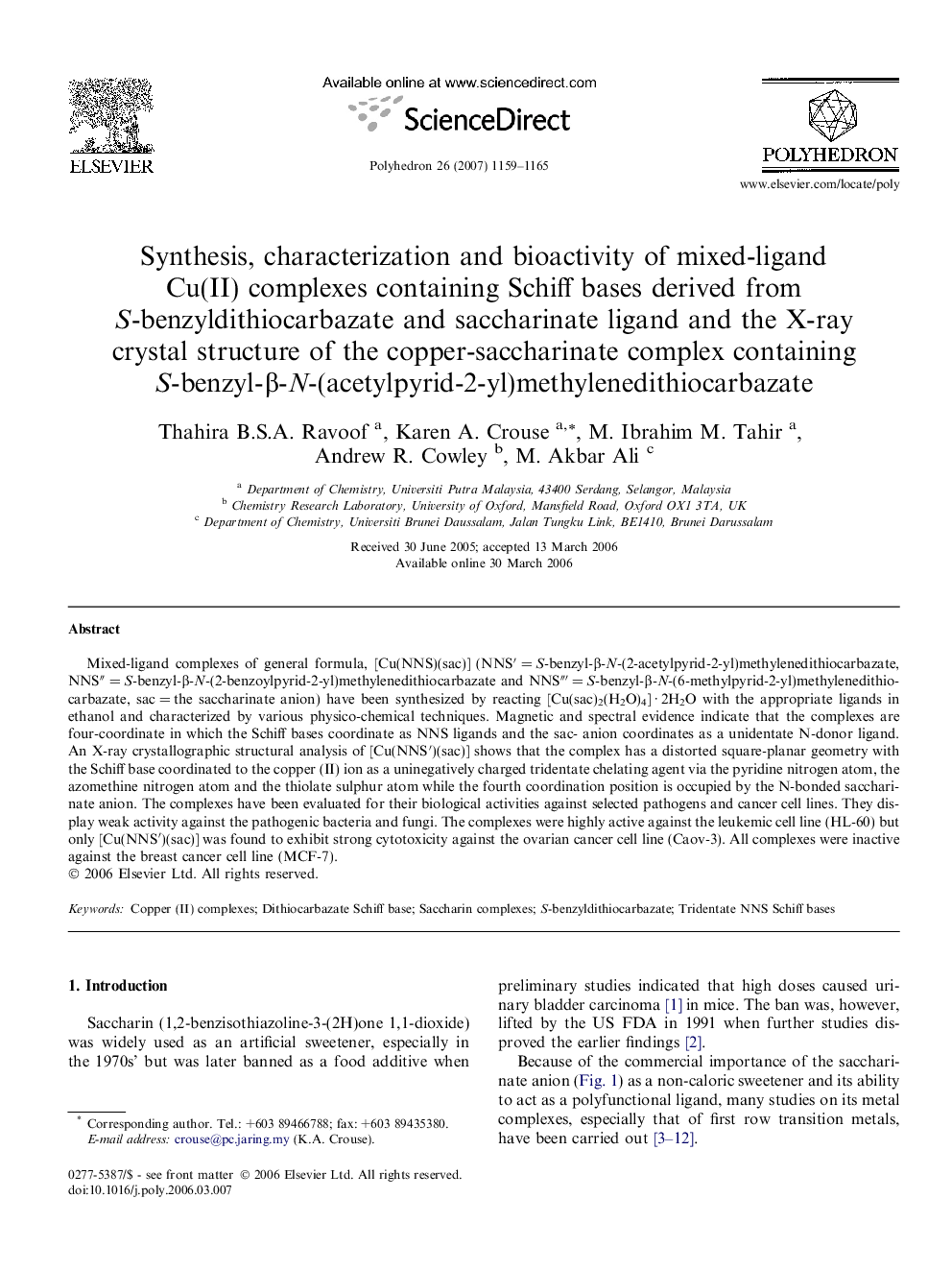| Article ID | Journal | Published Year | Pages | File Type |
|---|---|---|---|---|
| 1340211 | Polyhedron | 2007 | 7 Pages |
Mixed-ligand complexes of general formula, [Cu(NNS)(sac)] (NNS′ = S-benzyl-β-N-(2-acetylpyrid-2-yl)methylenedithiocarbazate, NNS″ = S-benzyl-β-N-(2-benzoylpyrid-2-yl)methylenedithiocarbazate and NNS‴ = S-benzyl-β-N-(6-methylpyrid-2-yl)methylenedithio-carbazate, sac = the saccharinate anion) have been synthesized by reacting [Cu(sac)2(H2O)4] · 2H2O with the appropriate ligands in ethanol and characterized by various physico-chemical techniques. Magnetic and spectral evidence indicate that the complexes are four-coordinate in which the Schiff bases coordinate as NNS ligands and the sac- anion coordinates as a unidentate N-donor ligand. An X-ray crystallographic structural analysis of [Cu(NNS′)(sac)] shows that the complex has a distorted square-planar geometry with the Schiff base coordinated to the copper (II) ion as a uninegatively charged tridentate chelating agent via the pyridine nitrogen atom, the azomethine nitrogen atom and the thiolate sulphur atom while the fourth coordination position is occupied by the N-bonded saccharinate anion. The complexes have been evaluated for their biological activities against selected pathogens and cancer cell lines. They display weak activity against the pathogenic bacteria and fungi. The complexes were highly active against the leukemic cell line (HL-60) but only [Cu(NNS′)(sac)] was found to exhibit strong cytotoxicity against the ovarian cancer cell line (Caov-3). All complexes were inactive against the breast cancer cell line (MCF-7).
Graphical abstractMixed-ligand complexes of general formula, [Cu(NNS)(sac)] ( NNS′ = S-benzyl-β-N-(2-acetylpyrid-2-yl)methylenedithiocarbazate, NNS″ = S-benzyl-β-N-(2-benzoylpyrid-2-yl)methylenedithiocarbazate and NNS‴ = S-benzyl-β-N-(6-methylpyrid-2-yl)methylenedithio-carbazate, sac = the saccharinate anion) have been synthesized and characterized. An X-ray crystallographic structural analysis of [Cu(NNS′)(sac)] shows that the complex has a distorted square-planar geometry with the Schiff base coordinated to the copper (II) ion as a uninegatively charged tridentate chelating agent via the pyridine nitrogen atom, the azomethine nitrogen atom and the thiolate sulphur atom while the fourth coordination position is occupied by the N-bonded saccharinate anion. The complexes have been evaluated for their biological activities against selected pathogens and cancer cell lines. They display weak activity against the bacteria and fungi. They are highly active against the leukemic cell line (HL-60) but only [Cu(NNS′)(sac)] exhibits strong cytotoxicity against the ovarian cancer cell line (Caov-3). All complexes are inactive against the breast cancer cell line (MCF-7).Figure optionsDownload full-size imageDownload as PowerPoint slide
